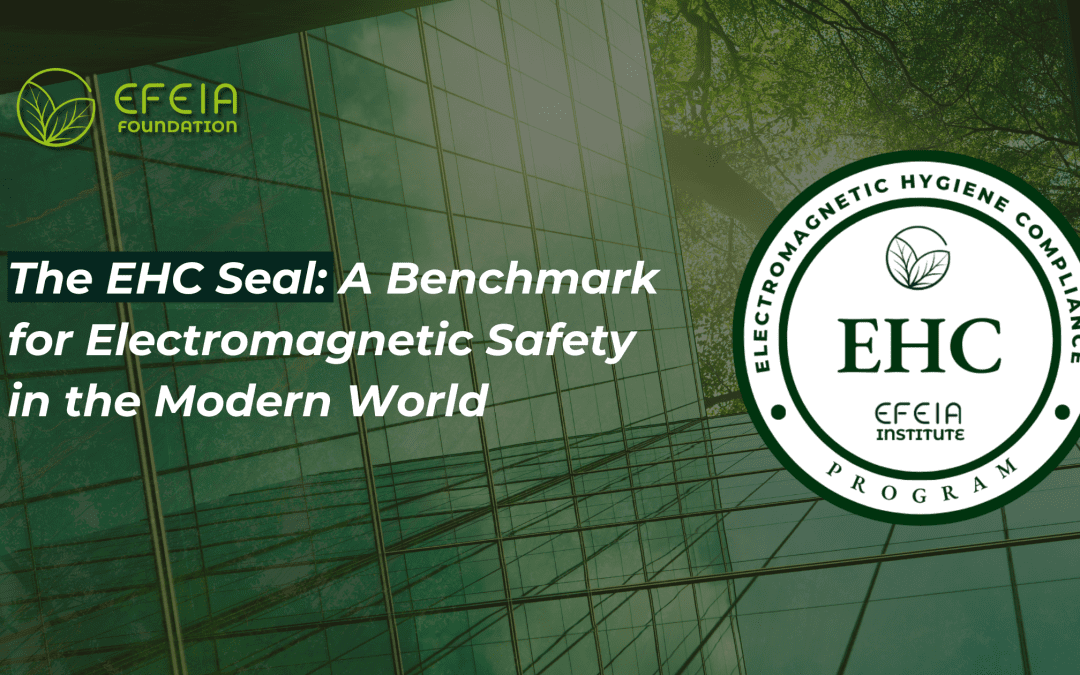In our increasingly connected world, electromagnetic fields (EMFs) have become an omnipresent yet largely invisible aspect of modern life.
In response to growing concerns about electromagnetic exposures in our technology-rich environments, the Electropollution Free Environment International Accreditation (EFEIA) has developed the EHC Seal—a certification mark that identifies spaces and technologies designed with electromagnetic safety as a priority.
What Makes the EHC Seal Different
Unlike traditional EMC (Electromagnetic Compatibility) certifications that focus solely on preventing electronic devices from interfering with each other, the EHC Seal evaluates biological compatibility through the Bio-Compatible Electromagnetic Compliance Program (BEMCP). This comprehensive assessment examines how electrical systems, technologies, and spaces affect the people who use them, not just how devices interact.
The certification process evaluates electromagnetic hygiene across multiple dimensions, establishing a tiered rating system that allows for continuous improvement. This science-based approach bridges the gap between technical compliance and biological safety, providing a framework for creating environments that support both technological functionality and human wellbeing.
Why Certification Matters
The EHC Seal serves multiple vital functions in advancing electromagnetic hygiene:
Objective Verification: The seal provides independent, third-party confirmation that a space or product has met specific, measurable standards for electromagnetic safety—cutting through marketing claims with science-based evaluation.
Design Framework: The BEMCP certification criteria establish clear benchmarks that guide designers, engineers, and manufacturers in creating electromagnetically safer environments and technologies from the initial design phase.
Market Differentiation: For forward-thinking organizations, the EHC Seal offers a competitive advantage in an increasingly health-conscious marketplace while driving broader industry adoption of electromagnetic hygiene practices.
The Certification Process
EHC certification is granted only after a rigorous BEMCP evaluation across eight critical dimensions of electromagnetic hygiene:
- Electrical Hygiene: Measurement and control of power quality, harmonics, and “dirty electricity”
- Infrastructure & Load Distribution: Strategic positioning and management of electrical systems
- Lighting Quality: Assessment of lighting systems for both spectral quality and emissions
- Environmental Quality: Integration of air quality and materials selection with EMF considerations
- ALARA Implementation: Verification of spatial distancing practices and exposure minimization
- SPIRO Filtering & Other mitigation technologies: Evaluation of advanced EMF mitigation technologies
- Scientific Validation: Review of measurement protocols and monitoring systems
- Educational Components: Assessment of awareness programs for occupants or users
Each dimension is evaluated on a five-tier performance rating system, with specific technical requirements for each level. Certification requires minimum performance thresholds across all criteria, with higher ratings earning more prestigious recognition.
Benefits Beyond Certification
Spaces and products that achieve the EHC Seal deliver quantifiable advantages beyond electromagnetic safety:
Extended Durability: BEMCP-certified designs typically incorporate higher-quality materials and components, resulting in longer operational lifespans and reduced electronic waste.
Energy Efficiency: Clean power systems with minimal harmonics operate more efficiently, reducing energy consumption by up to 15-20% in some certified environments.
Improved Performance: Electronic equipment in certified spaces often experiences fewer operational issues, as cleaner power and reduced interference support optimal functionality.
Measurable Wellness Impacts: Multiple case studies of certified environments report improvements in occupant sleep quality, concentration, and reduced reports of headaches and fatigue—particularly valuable in healthcare and educational settings.
Real-World Applications
The EHC Seal applies across four primary categories:
Spaces: From residential environments to offices, healthcare facilities, schools, and hospitality venues. Certification evaluates the space as an integrated electromagnetic system, considering both internal sources and external influences.
Technologies: Electronic devices, communication systems, and medical technologies can be certified by demonstrating minimized emissions while maintaining functionality.
Production Environments: Agricultural settings, manufacturing facilities, and food processing environments can achieve certification, acknowledging electromagnetic effects on biological processes.
Food Products: The final stage of the certification program will extend to food products, validating that they’ve been produced in electromagnetically clean environments throughout the supply chain.
Looking Forward
As electromagnetic awareness grows in both consumer and professional sectors, the EHC Seal establishes a science-based framework for evaluating and improving electromagnetic environments. Rather than advocating technological regression, the BEMCP certification promotes innovation directed toward more biologically compatible solutions.
For business leaders, the EHC Seal offers market differentiation in an increasingly health-conscious marketplace. For healthcare facilities, schools, and residential developers, it provides a comprehensive approach to creating electromagnetically safer environments. For manufacturers, it offers both design guidelines and third-party validation of electromagnetic safety claims.
The EHC Seal represents more than a certification—it embodies a vision where technological advancement and biological wellbeing progress in harmony. In a market increasingly concerned with creating truly healthy environments, this science-based standard offers a clear path forward for identifying and creating spaces and technologies that support human health without sacrificing the benefits of our connected world.

